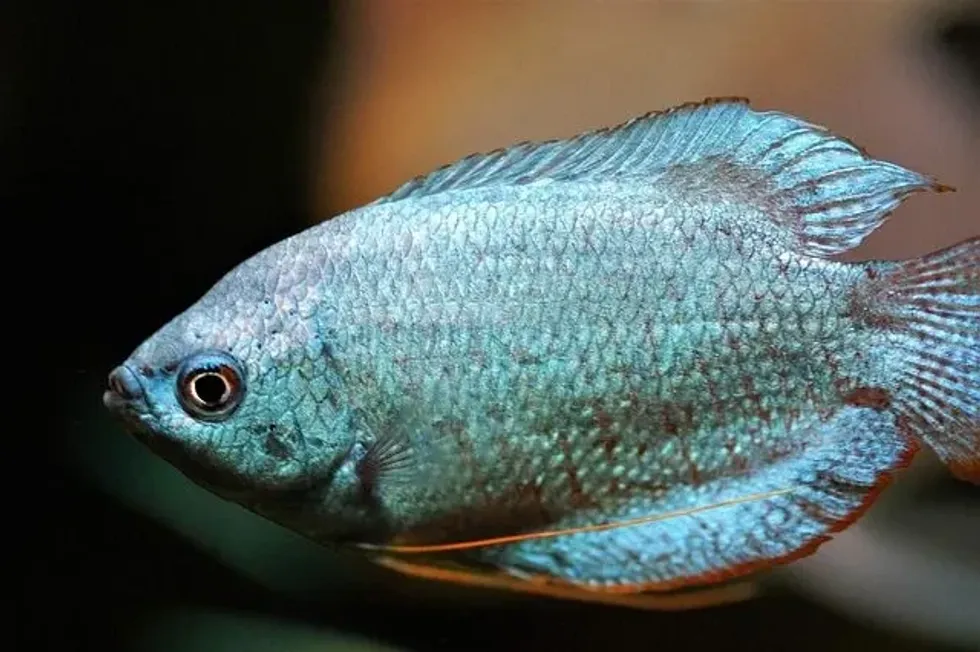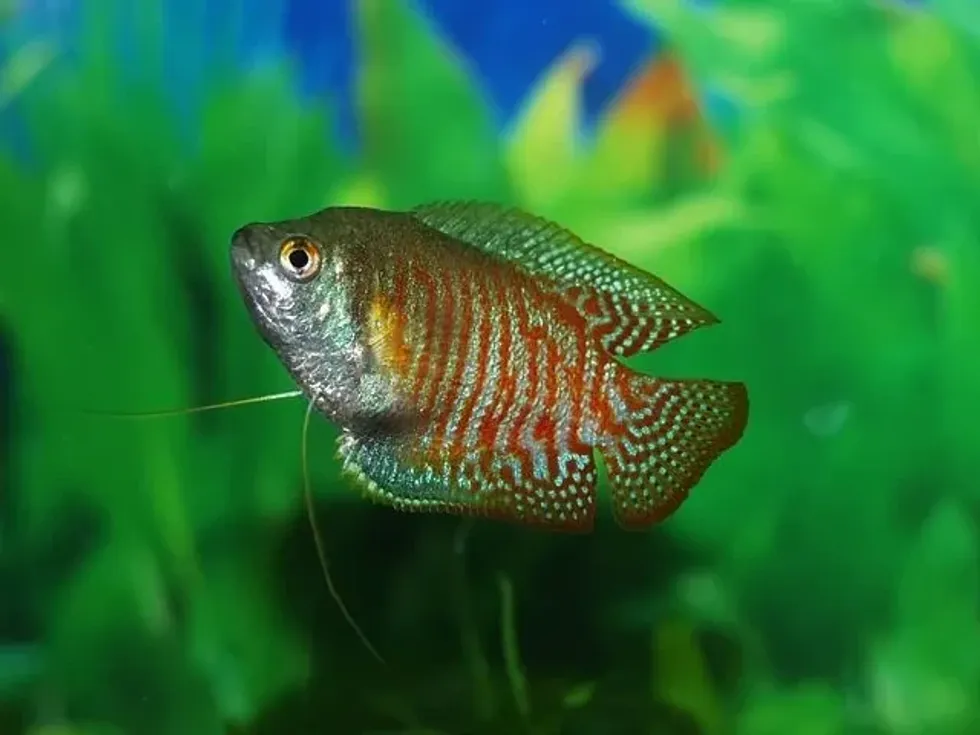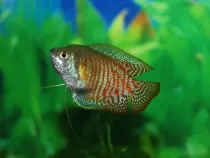Fun Gourami Facts For Kids

The gourami is a small to medium-sized fish from the order Anabantiform and family Osfronemidae that is found in freshwater. As labyrinth fish, they can survive in an environment with low oxygen levels.
Polyacanthidae is another name used for this family and the origin of this name is Indonesian. It is also the name for fish of the Anabantidae and Helostomatidae families.
These species are mouthbrooders, and some also build a bubble nest. This fish is found in canals, brooks, streams, and rivers with heavy vegetation in Thailand, Malaysia, and many more places.
They are found in various bright colors, and there are more than 133 species of gourami, including honey gourami and dwarf gourami. They adapt well to an aquarium environment if it is well-spaced and not crowded. However, they can get aggressive if there are more than two males in a tank.
Gouramis are of varying sizes and giant gourami fish can grow up to 2 ft (24 in) in length!. Most species of gourami are peaceful.
They are low-maintenance fishes and need intermediate levels of care. Owners can feed gourami fry brine shrimp for better growth.
Learn more about this amazing fish here, and for more interesting fish facts, check out our guides to mahi mahi and muskellunge fish too!
Gourami Interesting Facts
What type of animal is a gourami?
The gourami is a freshwater labyrinth fish. They are omnivorous and hardy fish. As there are several varieties, these fish can be peaceful or aggressive, small or huge, and outgoing or shy; it really depends on the individual species. They are popular aquarium fish but the typical gourami temperament can quickly become aggressive if and when they are provoked.
What class of animal does a gourami belong to?
The gourami fish belongs to the Actinopterygii class.
How many gourami are there in the world?
With more than 133 varieties of this species, the exact number of these fish in the world is unknown.
Where does a gourami live?
The gourami is a native fish of Asia. This fish is found in India, Pakistan, Malaysia, Thailand, Indonesia, and the Philippines. They are also aquarium fish that can be found around the world with an ideal aquarium temperature of 77-86 F (25-30 C) and a pH level of etween 6-7.5
What is a gourami's habitat?
The typical gourami habitat includes slow-moving rocky soil, and fresh, shallow water. They also inhabit high-temperature (tropical) waters. They can be found in streams, swamps, wetlands, and canals.
Who do gourami fish live with?
This fish lives on its own and aggressively guards its territory.
How long does a gourami live?
The average gourami lifespan is around four to eight years in the wild. In captivity, they live for about three to four years. On the other hand, giant gouramis can live up to 20 years in a big aquarium, and kissing gouramis only live for up to two years.
How do they reproduce?
The spawning process begins when a male and female touch each others antenna-looking pectoral fins. Some male species are mouthbrooders while other male species build a bubble nest to protect their eggs.
If the fish are bubble nesters then a male builds a bubble nest with layers of bubbles.
Females lay around 1000 eggs and male fish protect them by placing the surviving eggs in their nests. Mouthbrooding male species will place these eggs in their mouth until the eggs are ready to hatch, instead of in a bubble nest.
The aquarium breeding process requires a little more effort than native spawning. While breeding in a freshwater aquarium, fish owners must make sure to place just one breeding pair into a breeding tank.
Feeding them live foods, like brine shrimp or worms will increase their immunity leading to healthy spawning.
The spawning process is the same even in the breeding tank. The breeding tank must have the required water pH levels, an optimum water temperature, and low flow filtration to avoid breaking the nest.
Also, make sure to put long plants and other decorations in the tank. Once the eggs are hatched and placed in nests it is important to take the female out of the breeding tank.
The reason behind this is that male fish can becomes aggressive while protecting their nest, even towards their breeding partner.
After three days, gourami babies hatch from the eggs and the male fish might start feeding on the fry due to stress if they are left in the breeding aquarium. So, once the eggs are hatched it is important to take the male out of the breeding aquarium.
What is their conservation status?
Most species are listed as Least Concern. The pet trade, habitat loss, and pollution pose a threat to a few of these fish species, whilst other gourami fish species are high in population so face very few threats.
Gourami Fun Facts
What do gourami fish look like?
The gourami fish is found in a huge spectrum of colors. They have a stretched body with iridescent scales and males and females can be differentiated by color.
The well-known dwarf gourami female is a silvery color while the male dwarf gourami is blue or red in color. Other species are blue, pink, green, gold, and many other colors.
They have long fins and, in front of their pelvic fins, many species have a long feeler-like ray. One of the best gourami adaptations to take note of is their labyrinth. As they mostly lived in muddy and stagnant water, this acts as a lung and helps them to gulp in oxygen from the surface.
The dorsal and anal fins of this fish are pointed and are longer in males. The fins on their abdomen are as long as their body and they regrow if broken.

How cute are they?
The gourami has a small body and is vibrantly colored so it is quite a cute fish.
How do they communicate?
This fish communicates using touch and other senses. They make sounds while guarding their territory and they also use chemicals to communicate.
How big is a gourami?
Gouramis are 2-6 in (10-15 cm) long and 8 cm (3.1 in) tall. Mature males are sometimes smaller than mature females.
How fast can a gourami swim?
They are found along the surface of slow-flowing water so they are not fast swimmers. Their exact speed is unknown.
How much does a gourami weigh?
The gourami's exact weight is unknown but they are small and lightweight fish.
What are their male and female names of the species?
There are specific names given to a male or a female gourami.
What would you call a baby gourami?
Baby gouramis are called fry fish.
What do they eat?
The gourami diet is omnivorous. Their diet consists of invertebrates and small fish like brine shrimp, cricket, and worms. In places with high vegetation, their diet also includes debris and floating plants.
Are they dangerous?
Gouramis are not dangerous, but they can become aggressive when protecting their nests and if provoked. They have very small, but very sharp, teeth.
Would they make a good pet?
Yes, they make a good pet but they need a big tank that is not overcrowded. They require relatively low maintenance and intermediate care levels. In captivity, they can eat good quality dry food, legumes, and partially cooked vegetables and fruits.
Did you know...
The nicknames of honey gouramis are 'sunburst', 'flame', and 'honey flame' gouramis. They are a peaceful species and do well in a community tank.
The most vibrant and smallest of all gourami fish species is the dwarf gourami. Dwarf gouramis can also adapt to a high water temperature of about 81 F (27 C). Dwarf gouramis also carry iridovirus.
The stomach of a female gourami fish is rounder than that of a male but their dorsal fin is the most common difference.
Three spot gouramis are also called 'opaline', 'gold', and 'blue' gourami fish. The fish was given the name 'three spots' as they have spots on each side of their body that align with their eyes. This blue gourami is a native fish of Southeast Asia.
Kissing gouramis (Helostoma temmenckii) make kissing-like actions, hence their name. The reason for these actions has not yet been found but they are known to be good tank cleaners and they do well living with medium to large-sized fishes.
Females tolerate each other quite well but males can get aggressive with each other if kept in the same aquarium.
Climbing gouramis are given this name due to their ability to 'climb' out of the water and also 'walk' for a short distance with the help of their fins and tail.
The chocolate gourami (Sphaerichthys osphormenoides) is sensitive to water conditions and also cannot be kept with aggressive species. They are quite difficult to find. A few other gourami species to look for are pearl, banded, sparkling, snakeskin, licorice, and moonlight gourami fish.
Digestive problems faced by your pet gourami can be kept away by feeding them peas!
Do people eat gourami?
In a few parts of the world, giant gouramis (Osphronemus goramy) are a popular food. Deep-fried gouramies are served with sauces (such as sweet and sour sauce) and other spices in Southeast Asia. China targets gouramis for the cannery industry and these fish are available in Asian supermarkets. A lot of Sundanese food also includes this fish's meat.
Looking after your gourami
These species need specific conditions from their tank size to water flow and even the specific tank type. The minimum size of the tank should be 20 gallons (75.7 liters).
For most species, a tank of around 30 gallons (13.5 liters) is sufficient. For bigger species, you will need a tank with more than 55 gallons (208.1 liters).
The tank should be rectangular and tall. The water in the tank should have a low flow and be between 77-82 F (25-27.7 C), with a pH of about 6-8. To improve airflow in the tank, it is best to attach air pumps and air stones.
HOB filters and canister filters are also necessary. Several species are peaceful and if you have a community tank gouramis can be kept with other fishes.
Gouramis will do well with mollies, live bear fish, and guppy fish. If keeping two gouramis together, you will need to add another 5 gallons of tank space for every new gourami you wish to introduce.
The tank will need moderate lighting and lots of decorations as these fish species will become shy with fewer decorations. Hornwort, java ferns, and java moss are just some plants that can be kept in the tank with your gourami fish.
As they stay in the middle to the top of a tank, it is better to keep them with fish that are middle and bottom dwellers.
Here at Kidadl, we have carefully created lots of interesting family-friendly animal facts for everyone to discover! Learn more about some other fish including the vendace fish or the three spot gourami.
You can even occupy yourself at home by drawing one on our Gourami Fish coloring pages.
We Want Your Photos!
More for You
See All
Bachelor of Engineering specializing in Aeronautical/Aerospace Technology, Master of Business Administration specializing in Management

Arpitha RajendraBachelor of Engineering specializing in Aeronautical/Aerospace Technology, Master of Business Administration specializing in Management
With a background in Aeronautical Engineering and practical experience in various technical areas, Arpitha is a valuable member of the Kidadl content writing team. She did her Bachelor's degree in Engineering, specializing in Aeronautical Engineering, at Nitte Meenakshi Institute of Technology in 2020. Arpitha has honed her skills through her work with leading companies in Bangalore, where she contributed to several noteworthy projects, including the development of high-performance aircraft using morphing technology and the analysis of crack propagation using Abaqus XFEM.
Bachelor of Arts specializing in English Language and Literature, Master of Arts specializing in Philosophy and Religious Studies

Tehil DavidBachelor of Arts specializing in English Language and Literature, Master of Arts specializing in Philosophy and Religious Studies
Tehil David Singh is a fact checker with a Bachelor's degree in English literature from St.Xavier's College, Palayamkottai, and a Master's degree in Philosophy, and Religion from Madurai Kamaraj University. He has a passion for writing and hopes to become a story writer in the future. Tehil has previously interned in content writing and has been a content creator for the last three years. In his personal life, he enjoys singing, songwriting, performing, and writing stories.
Disclaimer
1) Kidadl is independent and to make our service free to you the reader we are supported by advertising. We hope you love our recommendations for products and services! What we suggest is selected independently by the Kidadl team. If you purchase using the Buy Now button we may earn a small commission. This does not influence our choices. Prices are correct and items are available at the time the article was published but we cannot guarantee that on the time of reading. Please note that Kidadl is a participant in the Amazon Services LLC Associates Program, an affiliate advertising program designed to provide a means for sites to earn advertising fees by advertising and linking to Amazon. We also link to other websites, but are not responsible for their content.
2) At Kidadl, we strive to recommend the very best activities and events. We will always aim to give you accurate information at the date of publication - however, information does change, so it’s important you do your own research, double-check and make the decision that is right for your family. We recognise that not all activities and ideas are appropriate for all children and families or in all circumstances. Our recommended activities are based on age but these are a guide. We recommend that these ideas are used as inspiration, that ideas are undertaken with appropriate adult supervision, and that each adult uses their own discretion and knowledge of their children to consider the safety and suitability. Kidadl cannot accept liability for the execution of these ideas, and parental supervision is advised at all times, as safety is paramount. Anyone using the information provided by Kidadl does so at their own risk and we can not accept liability if things go wrong.
3) Because we are an educational resource, we have quotes and facts about a range of historical and modern figures. We do not endorse the actions of or rhetoric of all the people included in these collections, but we think they are important for growing minds to learn about under the guidance of parents or guardians.







